A novel ball milling technique for room temperature processing of TiO2 nanoparticles employed as the electron transport layer in perovskite solar cells and modules†
Abstract
Anatase titanium dioxide (an-TiO2) is often used as the electron transporting material (ETM) in planar-heterojunction perovskite solar cells (PSCs) because of its excellent semiconductor characteristics, outstanding optical transmittance, and suitable band structure. Herein, we report an inexpensive method for mass-scale production of TiO2 ETMs at room temperature (RT ∼ 30 °C), involving the grinding of large clumps of an-TiO2 to form a suspension of TiO2 nanoparticles (NPs) in isopropyl alcohol for meso-superstructured PSCs. This process does not involve any chemical synthesis; it is a purely physical process. The lowest unoccupied molecular orbital (LUMO) of ground an-TiO2 NPs, estimated using ultraviolet photoelectron spectroscopy (UPS), was ca. 4.06 eV, which is a salient feature for the active layer. A regular perovskite solar cell (PSC) based on a CH3NH3PbI3 absorber and ground an-TiO2 ETL exhibited a champion power conversion efficiency (PCE) of 17.43% with an active area of 0.1 cm2. The same ground an-TiO2 NPs were used to fabricate a large-area (designated area: 25.2 cm2) PSC and a PCE of 14.19% was achieved. PSC devices incorporating the ground an-TiO2 NP ETLs exhibited an attractive long-term device stability, with the PCE retaining approximately 85% of the initial values after 80 days.

- This article is part of the themed collection: Industry R&D collection


 Please wait while we load your content...
Please wait while we load your content...